Spatial and Temporal Resolution of Global Protein Synthesis during HSV Infection Using Bioorthogonal Precursors and Click Chemistry
- PMID: 27706239
- PMCID: PMC5051704
- DOI: 10.1371/journal.ppat.1005927
Spatial and Temporal Resolution of Global Protein Synthesis during HSV Infection Using Bioorthogonal Precursors and Click Chemistry
Abstract
We used pulse-labeling with the methionine analogue homopropargylglycine (HPG) to investigate spatiotemporal aspects of protein synthesis during herpes simplex virus (HSV) infection. In vivo incorporation of HPG enables subsequent selective coupling of fluorochrome-capture reagents to newly synthesised proteins. We demonstrate that HPG labeling had no effect on cell viability, on accumulation of test early or late viral proteins, or on overall virus yields. HPG pulse-labeling followed by SDS-PAGE analysis confirmed incorporation into newly synthesised proteins, while parallel processing by in situ cycloaddition revealed new insight into spatiotemporal aspects of protein localisation during infection. A striking feature was the rapid accumulation of newly synthesised proteins not only in a general nuclear pattern but additionally in newly forming sub-compartments represented by small discrete foci. These newly synthesised protein domains (NPDs) were similar in size and morphology to PML domains but were more numerous, and whereas PML domains were progressively disrupted, NPDs were progressively induced and persisted. Immediate-early proteins ICP4 and ICP0 were excluded from NPDs, but using an ICP0 mutant defective in PML disruption, we show a clear spatial relationship between NPDs and PML domains with NPDs frequently forming immediately adjacent and co-joining persisting PML domains. Further analysis of location of the chaperone Hsc70 demonstrated that while NPDs formed early in infection without overt Hsc70 recruitment, later in infection Hsc70 showed pronounced recruitment frequently in a coat-like fashion around NPDs. Moreover, while ICP4 and ICP0 were excluded from NPDs, ICP22 showed selective recruitment. Our data indicate that NPDs represent early recruitment of host and viral de novo translated protein to distinct structural entities which are precursors to the previously described VICE domains involved in protein quality control in the nucleus, and reveal new features from which we propose spatially linked platforms of newly synthesised protein processing after nuclear import.
Conflict of interest statement
The authors have declared that no competing interests exist
Figures


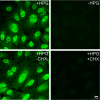
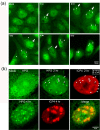



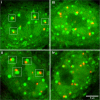



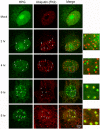


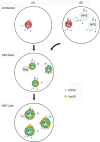
Similar articles
-
The Herpes Simplex Virus 1 Immediate Early Protein ICP22 Is a Functional Mimic of a Cellular J Protein.J Virol. 2020 Jan 31;94(4):e01564-19. doi: 10.1128/JVI.01564-19. Print 2020 Jan 31. J Virol. 2020. PMID: 31748398 Free PMC article.
-
Distinct temporal roles for the promyelocytic leukaemia (PML) protein in the sequential regulation of intracellular host immunity to HSV-1 infection.PLoS Pathog. 2018 Jan 8;14(1):e1006769. doi: 10.1371/journal.ppat.1006769. eCollection 2018 Jan. PLoS Pathog. 2018. PMID: 29309427 Free PMC article.
-
Prolonged gene expression and cell survival after infection by a herpes simplex virus mutant defective in the immediate-early genes encoding ICP4, ICP27, and ICP22.J Virol. 1996 Sep;70(9):6358-69. doi: 10.1128/JVI.70.9.6358-6369.1996. J Virol. 1996. PMID: 8709264 Free PMC article.
-
Herpes simplex virus type 1 immediate-early protein ICP22 is required for VICE domain formation during productive viral infection.J Virol. 2010 Mar;84(5):2384-94. doi: 10.1128/JVI.01686-09. Epub 2009 Dec 23. J Virol. 2010. PMID: 20032172 Free PMC article.
-
Recruitment of herpes simplex virus type 1 transcriptional regulatory protein ICP4 into foci juxtaposed to ND10 in live, infected cells.J Virol. 2003 Mar;77(6):3680-9. doi: 10.1128/jvi.77.6.3680-3689.2003. J Virol. 2003. PMID: 12610143 Free PMC article.
Cited by
-
The Herpes Simplex Virus 1 Immediate Early Protein ICP22 Is a Functional Mimic of a Cellular J Protein.J Virol. 2020 Jan 31;94(4):e01564-19. doi: 10.1128/JVI.01564-19. Print 2020 Jan 31. J Virol. 2020. PMID: 31748398 Free PMC article.
-
CENCAT enables immunometabolic profiling by measuring protein synthesis via bioorthogonal noncanonical amino acid tagging.Cell Rep Methods. 2024 Oct 21;4(10):100883. doi: 10.1016/j.crmeth.2024.100883. Cell Rep Methods. 2024. PMID: 39437716 Free PMC article.
-
Sequestration of ribosome biogenesis factors in HSV-1 nuclear aggregates revealed by spatially resolved thermal profiling.Sci Adv. 2025 Jun 27;11(26):eadw6814. doi: 10.1126/sciadv.adw6814. Epub 2025 Jun 27. Sci Adv. 2025. PMID: 40577456 Free PMC article.
-
Multifunctional viral protein γ34.5 manipulates nucleolar protein NOP53 for optimal viral replication of HSV-1.Cell Death Dis. 2018 Jan 24;9(2):103. doi: 10.1038/s41419-017-0116-2. Cell Death Dis. 2018. PMID: 29367603 Free PMC article.
-
Bioorthogonal Labelling of African Swine Fever Virus-Infected Cells.Methods Mol Biol. 2022;2503:195-204. doi: 10.1007/978-1-0716-2333-6_15. Methods Mol Biol. 2022. PMID: 35575897
References
-
- Flint SJ, Enquist LW, Krug RM, Racaniello VR, Skalka AM (2009) Principles of Virology. Washington DC: ASM Press.
MeSH terms
Grants and funding
LinkOut - more resources
Full Text Sources
Other Literature Sources
Medical
Miscellaneous

